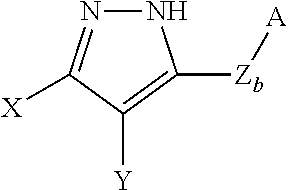Modified Fillers And Elastomeric Composites Comprising Same
a technology of elastomeric composites and fillers, which is applied in the field of fillers, elastomeric compositions or composites, can solve problems such as detriment of other properties, and achieve the effects of improving hysteresis in elastomeric compositions and improving abrasion resistance in elastomeric compositions
- Summary
- Abstract
- Description
- Claims
- Application Information
AI Technical Summary
Benefits of technology
Problems solved by technology
Method used
Image
Examples
example 1
Preparation of a Carbon Black Product
[0158]This example illustrates the preparation of a carbon black product of the present invention. A carbon black with an iodine number of 119 and a DBPA of 125 mL / 100 g was used.
[0159]A solution of 2.60 g NaNO2 in 21.7 g of water was added over a period of about five minutes to a stirring mixture of 150 g of the carbon black, 1301 g water, 5.00 g 3-amino-1,2,4-triazole-5-thiol and 5.14 g 70% methanesulfonic acid at 70 C. The mixing was continued for 50 minutes at 70 C. The mixture was cooled to room temperature and adjusted to a pH of 8.1 with NaOH solution. The product was collected by filtration, washed with 2.5 L of water and dried under vacuum at 70 C. The product had 1.53 wt % S. A sample of the carbon black product that had been subjected to Soxhlet extraction with methanol had 0.89 wt % S, compared to 0.65 wt % S for the untreated carbon black. The sample thus had attached and adsorbed triazoles.
example 2
Preparation of a Carbon Black Product
[0160]This example illustrates the preparation of a carbon black product of the present invention. A carbon black with an iodine number of 119 and a DBPA of 125 mL / 100 g was used. A solution of 2.61 g NaNO2 in 23.1 g of water was added over a period of ten minutes to a stirring mixture of 150 g of the carbon black, 1301 g water, 4.31 g 3-amino-1,2,4-triazole-5-thiol and 5.14 g 70% methanesulfonic acid at 70 C. The mixing was continued for an hour at 70 C. The mixture was cooled to room temperature and adjusted to a pH of 7.5 with NaOH solution. The product was collected by filtration, washed with 2.5 L of water and dried under vacuum at 70 C. The product had 1.41 wt % S. A sample of the carbon black product that had been subjected to Soxhlet extraction with methanol had 0.89 wt % S, compared to 0.65 wt % S for the untreated carbon black. The sample thus had attached and adsorbed triazoles.
example 3
Preparation of a Comparative Carbon Black Product
[0161]This example illustrates the preparation of a carbon black product modified using diazonium salts of APDS. A batch pelletizer having a mixing chamber with a 8″ diameter and 8″ length was heated to 60 C. and charged with 300 g of a carbon black with an iodine number of 119 and a DBPA of 125 mL / 100 g. 4-Aminophenyldisulfide (19.0 g) and 209 g of water were added. After mixing briefly, 29.0 g of 27.9% sulfuric acid was added. After mixing briefly, 52 g of a 20% solution of NaNO2 in water was added in a few portions, with brief intermediate mixing over five minutes. Water (50 g) was added, and mixing was continued for 30 min at 60 C, and the product was removed from the pelletizer, suspended in 4 L water and filtered. The product was washed with ethanol and then resuspended in 4 L of water. The pH was adjusted to 8 with NaOH solution, and the mixture was filtered and washed until the filtrate had a conductivity of 225 μS / cm. The pro...
PUM
| Property | Measurement | Unit |
|---|---|---|
| Elastomeric | aaaaa | aaaaa |
| Abrasion resistance | aaaaa | aaaaa |
| Hysteresis | aaaaa | aaaaa |
Abstract
Description
Claims
Application Information
 Login to View More
Login to View More - R&D
- Intellectual Property
- Life Sciences
- Materials
- Tech Scout
- Unparalleled Data Quality
- Higher Quality Content
- 60% Fewer Hallucinations
Browse by: Latest US Patents, China's latest patents, Technical Efficacy Thesaurus, Application Domain, Technology Topic, Popular Technical Reports.
© 2025 PatSnap. All rights reserved.Legal|Privacy policy|Modern Slavery Act Transparency Statement|Sitemap|About US| Contact US: help@patsnap.com



